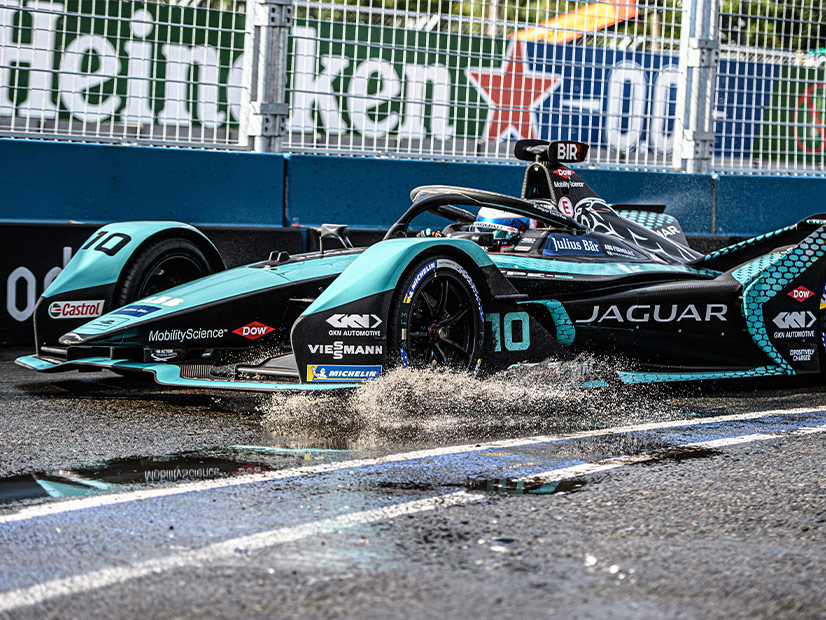The fastest race cars you’ll never hear coming flew through Brooklyn over the weekend in the ABB FIA Formula E World Championship New York City E-Prix.
British driver Sam Bird won the race in the Jaguar I-TYPE 5, an electric single-seat car that has a maximum speed of 174 mph and a maximum power of 250 kW (330 horsepower).
Anyone with even a passing fancy in Formula racing knows that Formula One race cars can trounce their electric counterparts, with a top speed of about 230 mph and a maximum horsepower of 1,000. So why is Formula E, the first and only EV racing series in the world, even a thing?
“We’re trying to use the sport as a way to promote electric mobility and to tell the story around what we think a brighter future can look like,” Jamie Reigle, CEO of Formula E, said in an ABB-hosted pre-race webcast on Friday.
Consider that, as compared to the Chevrolet Bolt, the I-TYPE 5’s top speed is 81 mph faster and its maximum power is 100 kW higher. Formula E is a testing ground for technologies that has put advancements in e-race cars on the fast track and bound for commercial electric vehicles.
That’s a paradigm already in place in traditional formula racing, which is defined by the regulated open-wheeled, single-seater cars used in the motorsport. Paddle shifters and carbon fiber construction are among the many road car technologies that started in formula race cars.
When Formula E launched in 2014, the cars’ batteries had only enough capacity for about 25 minutes of racing, which meant the teams had to swap cars during the race, Reigle said. Today, the races are longer, the battery capacity is much more significant, and there is no need to swap cars, he said.
All the races in the World Championship take place in cities to help promote the technology. The New York E-Prix was the latest race in the eight-city series that heads to London on July 24 and finishes up in Berlin in August.
“We bring electric mobility and electric racing into the heart of cities [because] we believe that electric mobility will be catalyzed most quickly by consumers in cities,” he said. “We can do that because the cars are quiet … they have zero emissions, and they’re environmentally friendly and work in that environment.”
The sport has attracted some of the biggest names in car manufacturing and racing — Porsche, Mercedes, Nissan and Jaguar — and Reigle said those companies are “making bets” on their ability to compete in the electric car racing environment.
Formula E also has a clear technology roadmap.
“Right now, we’re in what we call Gen2, and we’ll be moving to Gen3 in 18 months,” he said.
The next generation of cars will be about 200 pounds lighter because of advancements in battery technology, and the maximum power will increase by 100 kW. Gen3 also will push the limits on charging with an anticipated flash-charge at 800 kW. By comparison, top-tier commercial charging ports — direct-current fast chargers — supply power at between 50 and 350 kW.
Those technological advancements offer a sneak peek into how the consumer EV market will change in the coming years, as the technology trickles down from the racetrack to the road.
Granholm v Buemi
U.S. Energy Secretary Jennifer Granholm compared notes on EVs during the pre-race webcast with Swiss driver Sebastien Buemi, a veteran of Formula E currently driving for Nissan’s e.dams team.
Buemi took 15th place during the New York E-Prix driving the Nissan IM03. He joined Formula E in 2014 from the traditional Formula racing circuit.
“As a racing driver, I’ve been attracted by the fact that this for me was the future from the very beginning,” Buemi said. “But I was not expecting this kind of improvement in the technology over the years.”
He credits Formula E with targeting the environmental and technical elements of EVs in its core purpose.
“The FIA [International Automobile Federation] and Formula E have tried to come up with a regulation that can keep the cost down because the idea is to be sustainable,” he said. “It’s an amazing platform, but at the same time, we want to make it sustainable in terms of budget and also being a laboratory for the normal road car manufacturer.”
Granholm said the Department of Energy shares that purpose through its focus on R&D that will make manufacturing and deploying EVs easier.
“Since January we … have already invested about $362 million in EVs and batteries,” she said.
DOE’s research also is targeting battery charging capabilities with a goal of achieving a 300-mile range with 15 minutes of charging for all vehicles. And the department wants to scale up U.S. battery manufacturing across the entire supply chain.
“That’s going to help us to procure and deploy EV batteries at the speed and the scale that we need to reach our climate and clean energy goals,” she said.
Buemi sees a similar focus on EV advancements in Europe.
“In my city, I see more and more electric charging points; the technology is improving; and the time to recharge the cars is getting faster,” he said. “I want to use Formula E to bring a message across that people should not be scared to buy an electric car today.”
With plenty of charging stations already in place and EVs that have a “good range,” he said, “it’s not a question of if; it’s just a question of when everyone will drive an electric car.”


